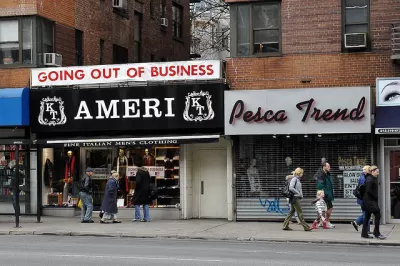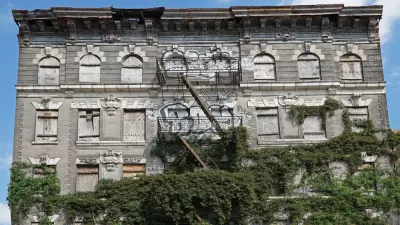Between 2016 and 2017 vacant store fronts nearly tripled in New York.

From Prospect Heights to Times Square, vacant commercial spaces are spreading all over New York. "A survey conducted by Douglas Elliman found that about 20 percent of all retail space in Manhattan is currently vacant, she said, compared with roughly 7 percent in 2016," Corey Kilgannon reports for the New York Times.
A growing economy is pushing up costs, especially in neighborhoods that are becoming wealthy. Other factors cited by retail watchers include the continued growth of online retail and a practice called "warehousing" store fronts. Some believe that property owners with the means to forgo rents will keep properties off the market in order to secure longer leases or higher rents. Mayor, Bill de Blasio, has said he would support a vacancy tax to try to dissuade the practice.
Whatever the cause, the effect is clear. "Soaring rents and competition from online shopping have forced out many beloved mom-and-pop shops, which many residents say decimates neighborhoods and threatens New York’s unique character," Kilgannon writes.
FULL STORY: This Space Available

Planetizen Federal Action Tracker
A weekly monitor of how Trump’s orders and actions are impacting planners and planning in America.

San Francisco's School District Spent $105M To Build Affordable Housing for Teachers — And That's Just the Beginning
SFUSD joins a growing list of school districts using their land holdings to address housing affordability challenges faced by their own employees.

The Tiny, Adorable $7,000 Car Turning Japan Onto EVs
The single seat Mibot charges from a regular plug as quickly as an iPad, and is about half the price of an average EV.

Seattle's Plan for Adopting Driverless Cars
Equity, safety, accessibility and affordability are front of mind as the city prepares for robotaxis and other autonomous vehicles.

As Trump Phases Out FEMA, Is It Time to Flee the Floodplains?
With less federal funding available for disaster relief efforts, the need to relocate at-risk communities is more urgent than ever.

With Protected Lanes, 460% More People Commute by Bike
For those needing more ammo, more data proving what we already knew is here.
Urban Design for Planners 1: Software Tools
This six-course series explores essential urban design concepts using open source software and equips planners with the tools they need to participate fully in the urban design process.
Planning for Universal Design
Learn the tools for implementing Universal Design in planning regulations.
Smith Gee Studio
City of Charlotte
City of Camden Redevelopment Agency
City of Astoria
Transportation Research & Education Center (TREC) at Portland State University
US High Speed Rail Association
City of Camden Redevelopment Agency
Municipality of Princeton (NJ)





























